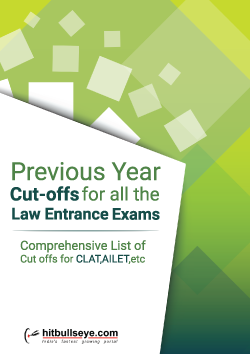Every year Symbiosis Law School, Pune (SLS) conducts Symbiosis Entrance Test (SLAT) for admission to its undergraduate Institutes of Symbiosis International University. Each institute including Symbiosis Law School has its independent selection process.
SET – Law (as SLAT was previously called) 2016 was conducted in a paper based mode at various centers across the nation. It had 150 questions which had to be solved in 150 minutes. There was no negative marking in SET-Law 2016. Following were the different sections of the exam:
| Areas |
No. of Questions |
Level of Difficulty |
| Logical Reasoning |
30 |
Moderate |
| Legal Reasoning |
30 |
Easy- Moderate |
| Analytical Reasoning |
30 |
Moderate- Difficult |
| Reading Comprehension |
30 |
Easy |
| General Knowledge |
30 |
Moderate |
| Overall |
150 |
Moderate |
Following is a section wise analysis of SET-Law 2016:
Legal Reasoning:
The SET Law 2016 Legal Reasoning had the following division of questions:
| Question Type |
No. of questions |
| Principle-fact |
14 |
| Legal Fact |
10 |
| Legal GK |
4 |
| Assertion Reason |
2 |
Subject-wise Breakup of the Legal Reasoning Section:
| Subject Area |
No. of questions |
| Constitution |
7 |
| Contract |
8 |
| Indian Penal Code |
7 |
| Torts |
6 |
| Legal Misc. |
2 |
Evaluation: Similar to the last year pattern, SET-Law 2016's legal reasoning section was dominated by principle-fact questions, followed by legal fact questions. The subject areas of constitution, contract, Indian Penal Code and Law of Torts were given, a more or less, equal weightage. There were few legal G.K questions based on current affairs. The average attempt for this section would be 24- 27 questions.
Logical Reasoning:
The Logical Reasoning section of SET-Law 2015 had questions from the following areas:
| Areas |
No. of questions |
| Arrangements |
14 |
| Direction |
1 |
| Syllogism |
1 |
| Data Sufficiency |
3 |
| Probability |
2 |
| Cause and Effect |
2 |
| Conclusions (Verbal Based) |
1 |
| Strong and Weak Arguments |
2 |
| Critical Reasoning |
2 |
| Odd Man Out |
1 |
| Misc. |
1 |
| Total |
30 |
Evaluation: The overall level of difficulty of this section was moderate to difficult. Majority of the questions were from arrangements. Other different question type areas were: direction, syllogism, data sufficiency, cause and effect, strong and weak arguments, etc. A score of around 22-23 can be considered a good score in this particular section.
Analytical Reasoning:
| Series |
6 |
| Ratio |
1 |
| Average |
1 |
| Time and Work |
2 |
| Speed, Distance and Time |
2 |
| Probability |
2 |
| Data Sufficiency |
2 |
| Algebra |
1 |
| Clocks and Calendar |
4 |
| Coding Decoding |
5 |
| CI |
1 |
| Cause and Effect |
3 |
| Total |
30 |
Evaluation: The level of difficulty of this section ranged from moderate to difficult. The broad areas that were covered were: series, coding- decoding, clocks and calendars, cause and effect, data sufficiency, time and work, etc. The candidates who prepared well were able to solve questions in a time span of 30-35 minutes. An average attempt of 22-24 questions can be considered good to score well in the test.
Reading Comprehension:
| Area |
No. of Questions |
| 6 Paragraphs |
5 questions each |
Evaluation: The reading comprehension section consisted of 6 paragraphs followed by five questions each. All the paragraphs were of a short length (approximate 7-8 lines). 1st paragraph talked about the investment that parents make for their children and attitude of children towards them. Questions were based on vocabulary and facts which were easy. 2nd paragraph talked about the fact that how the identification of a problem, in the beginning, can lead to its correction and sales can be increased after that. Questions were based on facts and were easy. 3rd paragraph talked about communism, fascism, and socialism in India. Questions were based on vocabulary and facts and were of a medium level. 4th paragraph discussed the right to public services act with questions based on vocabulary and factual information. The questions in this paragraph were a little difficult. 5thparagraph spoke about securing women rights. Questions were based on inference and title. Also, factual questions were there. Last paragraph talked about politics, economics, and net neutrality. There were questions based on vocabulary and descriptive analysis which were doable. So, all the more questions were factual and vocabulary based.
General Knowledge:
Following is a breakup of the questions in the General Knowledge Section of SET- Law 2016:
| Area |
No. of questions |
| Current |
7 |
| Static |
23 |
Static GK
| Area |
No. of questions |
| International and National Org. |
1 |
| Govt. Schemes and Policy |
2 |
| Science and Technology |
1 |
| Books, Authors, Art, Culture |
3 |
| Indian Polity |
3 |
| Indian History |
3 |
| World Geography |
3 |
| Sports |
1 |
| Miscellaneous |
6 |
Current GK:
| Area |
No. of questions |
| Books, Authors, Art, Culture |
2 |
| International and National Org. |
1 |
| Miscellaneous |
4 |
Evaluation: This section comprised questions from both static and current GK with Static GK dominating the area. A thoroughly prepared candidate would be able to attempt at least 27 questions and would be able to score between 25-28 marks.
Download the following PDFs to maximize your SET - Law Score:

Download PDF

Download PDF

